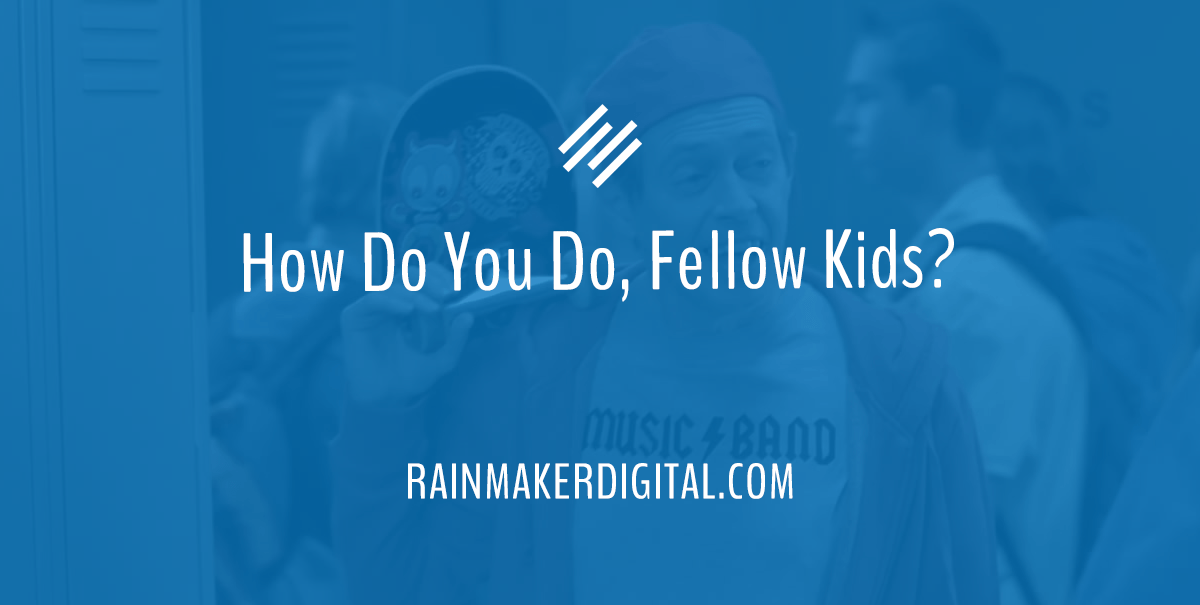
You’ve probably seen this meme.
It’s usually a reply to some inauthentic attempt by a company to appear “in touch” or appeal to a group they’re not a part of. Authenticity has been an issue since the very dawn of commercial communication.

Some inauthenticity comes from deception or misrepresentation. The famous “4 out of 5 dentists” or “80% of dentists” claims by toothpaste and gum companies have come under heavy fire over the last few years, as the information left out makes the studies highly misleading. Many of these “dentist claims” brought legal action.
Inauthenticity can also come from trying to be something you’re not. Reddit’s irreverent, informal “Ask Me Anything” Q&A format has had several stiff and inauthentic attempts at publicity without engagement over its lifetime. One of the most famous is the infamous Woody Harrellson “Let’s talk about Rampart” session where every question was pointed back to promotion for his upcoming movie. Harrellson’s complete misunderstanding of the format invited ridicule and public hostility.

Harrellson received these reactions because he only thought of what he could get from the audience, not whether he could provide them value.
Would you approach your personal relationships this way?
It would be incredibly stupid. And you probably wouldn’t have many friends.
Authenticity matters. Your brand has to care about your audience if you want them to care about you. Today, you are more than just a business or a brand to your customers. You’re a part of their identity.
I Just Want to Do Business. Do I Have to Be Authentic?
Yes.
Times are changing. In 2020, 83% of Millennials said they wanted brands to align with their values. 65% had boycotted a brand over its stance on an issue. 62% said they favored products aligning with their beliefs. That’s a marked contrast to those 55 and up, with only 21% favoring products that aligned with them. The trend seems to be holding with Generation Z.
It’s getting harder and harder to be “just a business.” Your company’s values have to be a part of the brand — you can’t hide behind the brand any more. You have to be authentic.
The Components of an Authentic Brand
What makes a company’s brand authentic?
The Right Content
Your content has to match what people expect from you. One of the best examples of this is FrackFeed, a currently defunct website devoted to oil and gas memes. Its Facebook page still has nearly 150,000 followers, but the engagement is shockingly low. It reads like an attempt to cash in on Internet culture without understanding it.

What sort of content do people expect from you? Just because someone tells you Millennials like snarky Internet memes doesn’t mean they want them from the brands that heat their apartments.
The Right Audience
Your brand and audience have to be aligned or the brand will fail. A great example of this is Patagonia — created by an outdoorsman, the company builds time for outdoor trips into the employee schedule and donates large sums of money to environmental causes. It resonates with people who share those same values. From this base of shared values, Patagonia has been able to expand to other communities with similar interests.
The Right Platforms
A big part of authenticity is choosing the right platforms to reach your audience. That sometimes means reevaluating where the brand needs to be present — this happened with Pedialyte in 2015, when they expanded into new social media avenues like Instagram to focus on their growing young adult market.
Willingness to Sacrifice
An authentic brand will be willing to sacrifice to maintain its integrity. One of the best examples of this is Patagonia’s 2011 “Don’t Buy This Jacket” Black Friday campaign, in which they called for people to “buy less and buy more thoughtfully.”
Why run a campaign asking people to not buy your product? For Patagonia, valuing the environment and minimizing waste is one of their core tenets. Encouraging people not to buy unneeded gear demonstrated their core values. And it worked in the long-term too. Their revenue grew 30% in 2012.
It’s easy to craft a mission statement full of nice-sounding corporate buzzwords. It’s a lot harder to make your brand live by it. Say what you mean and mean what you say — your customers will respect it.
Internal Alignment
What you say must flow from who you are. To be authentic, you have to start from within.
How much does your company look like your customer base? And how much do they understand them? There are plenty of cases of companies committing major faux pas because of not understanding the culture of their audience. One great example is Dolce & Gabbana, which had to cancel their Shanghai fashion show in November of 2018 after an insensitive ad created a massive Chinese backlash. The ad and events surrounding it did massive harm to the company’s image in China.
Consistency matters. Smart organizations have a single set of values that they apply throughout the organization. It’s hard to talk about how much you care about people if your company is run like a sweatshop. That “we care” campaign you worked so hard on won’t mean much when someone’s Twitter thread on your bad labor practices goes viral.
A Win-Win Situation
In a world that’s growing more and more transparent, you can’t hide behind the brand. It matters who you are, and your brand values need to overlap with your audience’s.
Authenticity means not asking “what’s in it for me,” but “what’s in it for us.” Choose your opportunities carefully. Sometimes cutting your losses and not pursuing a really attractive chance is worth it if it would be a betrayal of your brand.
This might sound scary. It shouldn’t. To quote Gary Vaynerchuk, “Selling isn’t scary. Selling something you don’t believe in is.” If you’re in business just to get value out of people, they’ll realize it sooner or later. Don’t approach your brand with the intent of just getting value. Provide it.
The long-term strategy for business success is one where both your brand and your audience win. One where you care about them and they care about you.
That’s authenticity.
Need help with your brand? Know that you don’t need to go it alone. We’re in this with you. If you need a little help, just drop us a line, anytime.
Best Regards,
Ed Bardwell
President
Rainmaker Digital Services